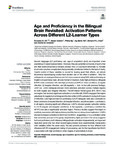Age and Proficiency in the Bilingual Brain Revisited: Activation Patterns Across Different L2-Learner Types
| dc.contributor.author | Oh, Tomasina M | |
| dc.contributor.author | Graham, S | |
| dc.contributor.author | Ng, P | |
| dc.contributor.author | Yeh, IB | |
| dc.contributor.author | Chan, BPL | |
| dc.contributor.author | Edwards, AM | |
| dc.date.accessioned | 2019-09-06T13:50:55Z | |
| dc.date.available | 2019-09-06T13:50:55Z | |
| dc.date.issued | 2019-01-01 | |
| dc.identifier.issn | 2297-900X | |
| dc.identifier.issn | 2297-900X | |
| dc.identifier.uri | http://hdl.handle.net/10026.1/14884 | |
| dc.description.abstract |
Second language (L2) proficiency and age of acquisition (AoA) are important when examining L2 neural representation. However, they are potential confounds of each other and their relative importance remains unclear. How L2 was learnt (informally vs. formally at school) is another complication that potentially contributes further to this lack of clarity. Careful control of these variables is crucial for teasing apart their effects, yet almost all previous neuroimaging studies have studied one or the other in isolation. Thirty five participants of varying proficiency and AoA were scanned using fMRI while performing an English (L2) past tense task; all were formal L2 learners. Early high proficiency bilinguals (EAHP) were contrasted with late high proficiency (LAHP) in three conditions: (i) regular inflection; (ii) irregular inflection; and (iii) regularity × AoA. In line with previous findings, LAHP (vs. EAHP) bilinguals showed more extensive activation across multiple regions for both regular and irregular inflection. The left inferior frontal gyrus (IFG; BA47) was one region that showed significant activation in condition (iii). EAHPs engaged this region selectively for regular but not irregular inflection while LAHPs activated it during both types of inflection. Late high and late low proficiency (LALP) bilinguals were also contrasted in three conditions: (i) regular inflection; (ii) irregular inflection; and (iii) regularity × proficiency. In all regions showing significant differences, LAHPs showed greater activation relative to LALPs (regular and irregular conditions). In the regularity × proficiency condition the left IFG was also a significantly activated region. Previous studies suggest this region is positively associated with high proficiency but this has not always been replicated. LAHPs showed increased activation in BA45 but not BA44, suggesting L2 is a controlled rather than automatic process in this group despite being highly proficient. Our study suggests AoA and proficiency both influence bilingual brain activation independently, an important replication given only two other neuroimaging studies have experimentally manipulated both variables within the same study. We also provide evidence for how different AoA influences left IFG engagement during L2 processing, and for the hypothesis that BA45 is associated with high proficiency when degree of automaticity is lower. | |
| dc.format.extent | 39- | |
| dc.language.iso | en | |
| dc.publisher | Frontiers Media SA | |
| dc.subject | Clinical Research | |
| dc.subject | Neurosciences | |
| dc.subject | Neurological | |
| dc.subject | 4 Quality Education | |
| dc.title | Age and Proficiency in the Bilingual Brain Revisited: Activation Patterns Across Different L2-Learner Types | |
| dc.type | journal-article | |
| dc.type | Journal Article | |
| plymouth.volume | 4 | |
| plymouth.publication-status | Published online | |
| plymouth.journal | Frontiers in Communication | |
| dc.identifier.doi | 10.3389/fcomm.2019.00039 | |
| plymouth.organisational-group | /Plymouth | |
| plymouth.organisational-group | /Plymouth/Faculty of Health | |
| plymouth.organisational-group | /Plymouth/Faculty of Health/Peninsula Medical School | |
| plymouth.organisational-group | /Plymouth/REF 2021 Researchers by UoA | |
| plymouth.organisational-group | /Plymouth/REF 2021 Researchers by UoA/UoA03 Allied Health Professions, Dentistry, Nursing and Pharmacy | |
| plymouth.organisational-group | /Plymouth/Research Groups | |
| plymouth.organisational-group | /Plymouth/Research Groups/FoH - Community and Primary Care | |
| plymouth.organisational-group | /Plymouth/Research Groups/Plymouth Institute of Health and Care Research (PIHR) | |
| plymouth.organisational-group | /Plymouth/Users by role | |
| plymouth.organisational-group | /Plymouth/Users by role/Academics | |
| dcterms.dateAccepted | 2019-07-08 | |
| dc.rights.embargodate | 2019-9-10 | |
| dc.identifier.eissn | 2297-900X | |
| dc.rights.embargoperiod | Not known | |
| rioxxterms.version | Version of Record | |
| rioxxterms.versionofrecord | 10.3389/fcomm.2019.00039 | |
| rioxxterms.licenseref.uri | http://www.rioxx.net/licenses/all-rights-reserved | |
| rioxxterms.type | Journal Article/Review |


